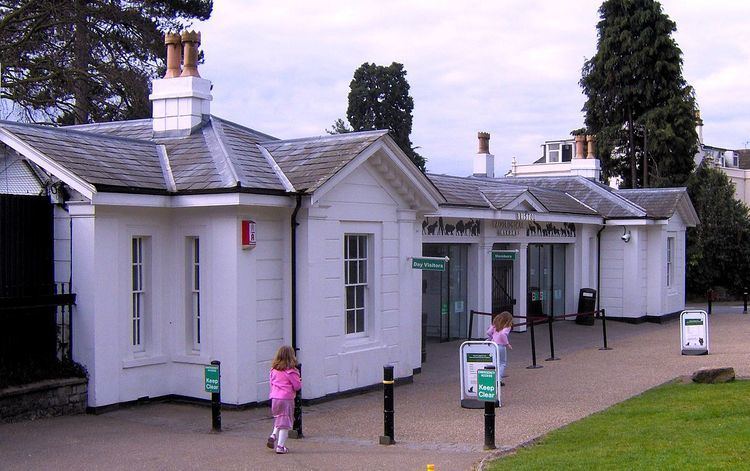Date opened 1836 Land area 12 acres (5 ha) No. of species 419 (2007) Phone +44 117 428 5300 | No. of animals 7155 (2007) Opened 1836 | |
 | ||
Address College Rd, Clifton, Bristol BS8 3HA, UK Hours Closed now Friday9AM–5PMSaturday9AM–5PMSunday9AM–5PMMonday9AM–5PMTuesday9AM–5PMWednesday9AM–5PMThursday9AM–5PM Notable animals Jasmina, Biggie, Sirana, Romina, Jay, Duana, Kamal, Lodja, Namoki, Rubani, Luani, Salome, Nato, Shiva, Komale, Moti, Samuel, Chandra, Jock, Kaly Similar Wild Place Project, Bristol Aquarium, Clifton Suspension Bridge, Noah's Ark Zoo Farm, SS Great Britain Profiles | ||
Bristol zoo day out
Bristol Zoo is a zoo in the city of Bristol in South West England. The zoo's stated mission is "Bristol Zoo Gardens maintains and defends biodiversity through breeding endangered species, conserving threatened species and habitats and promoting a wider understanding of the natural world".
Contents
The mammal collection at the zoo numbers around 300, representing 50 species, including: okapis, which Bristol was one of the first zoos in the world to breed, Asiatic lions, pygmy hippos, and red pandas. Among species now on view at Bristol which are rare or absent in other UK zoos are Livingstone's fruit bats and successful breeding groups of western lowland gorillas and aye ayes.
The zoo's Twilight Zone was the first of its kind when it opened, there are many other indoor exhibits including an insect and reptile house and aquarium meanwhile outside there are several aviaries and a seal and penguin enclosure. The lakes' islands are home to gorillas, tamarins, marmosets, gibbons and pelicans.
Animal exhibits
History
Opened in 1836 by the Bristol, Clifton and West of England Zoological Society, Bristol Zoo is the world's oldest provincial zoo. It is a Victorian walled zoo located between Clifton Down and Clifton College, near Brunel's Clifton Suspension Bridge; it covers a small area by modern standards, but with a considerable number of species. In the 1960s the zoo came to national prominence by appearing in the UK television series, Animal Magic, hosted by the comic animal 'communicator', Johnny Morris. Morris would play keeper and voice all the animals there.
The zoo's official name is Bristol Zoological Gardens ('Bristol Zoo Gardens' for commercial purposes). This is not in recognition of the flower displays but recognises the first use of that title at the Regent's Park Zoological Gardens. Bristol, like its earlier London counterpart, includes several original buildings which have been praised for their architectural quirks, despite being unsuitable for the care of animals; the (former) Giraffe House joins the main entrance lodge and the south gates on Guthrie Road as a Grade II listed building. The old Monkey Temple, resembling a southern-Asian temple, is now home to an exhibit called "Smarty plants", an interactive exhibit which shows how plants use and manipulate animals to survive.
The zoo also has breeding firsts, including the first black rhino born in Britain in 1958, the first squirrel monkey born in captivity in 1953 and the first chimpanzee born in Europe in 1934.
In December 2014, the zoo lost three of its rarest animals after two fatal incidents, including one involving a male warty pig which killed its own baby. The pig also attacked the baby's mother who had to be put down. In a separate incident a few days later, a South American monkey was also eaten by an otter.
Conservation
Bristol Zoo supports wildlife conservation, education and breeding programmes worldwide. For example, Bristol works with other zoos around the world to breed lemurs in captivity. Native to Madagascar, the lemurs are critically endangered because their forest habitat is being destroyed.
Bristol Zoo supports the UK/US charity Ape Action Africa, which rescues and rehabilitates primates in Cameroon, West Africa.
Closer to home, the zoo has helped to reintroduce the water vole to parts of Southern England.
Wild Place Project
A number of mammals are kept on a site to the north of Bristol and there are plans to relocate many more species to the Hollywood Tower estate near Cribbs Causeway, as part of a second zoo.
The new site is called the Wild Place Project, and is designed to house larger animals than the existing Bristol Zoo. The zoo is split into biomes, representing species found only in specific habitats. Current areas include: Secret Congo, native European woodland, Edge of Africa and Madagascar. The species list currently includes: okapi, Red River Hog, Sudan cheetah, zebra, Common Eland, Grey Wolf and Gelada Baboon.
Some of the biomes to be included are: Central American Swamp, Sumatra Tropical Forest, Nepal Riverine Forest, Coral Reef and British Wetlands. The species list for each ecosystem has not yet been finalised, but is likely to include manatees, crocodiles, bonobos, bongo, Bengal tiger, orangutan, giraffe, zebra, warthog, lion, kudu, African hunting dog, rhinoceros and brown bear.
The site officially opened on 22 July 2013 as Wild Place Project.
Event hosting
The WOMAD music festival came to the zoo in 2011, with a subsequent event in 2012.
